The city of Nagasaki in southern Japan marks the 75th anniversary of the U.S. atomic bombing on Sunday.
It was the second nuclear bomb dropped by the U.S. three days after the attack on Hiroshima. Japan surrendered on Aug. 15, ending World War II and nearly a half-century aggression against its Asian neighbors.
Dwindling survivors, whose average age exceeds 83, increasingly worry about passing their lessons on to younger generations.
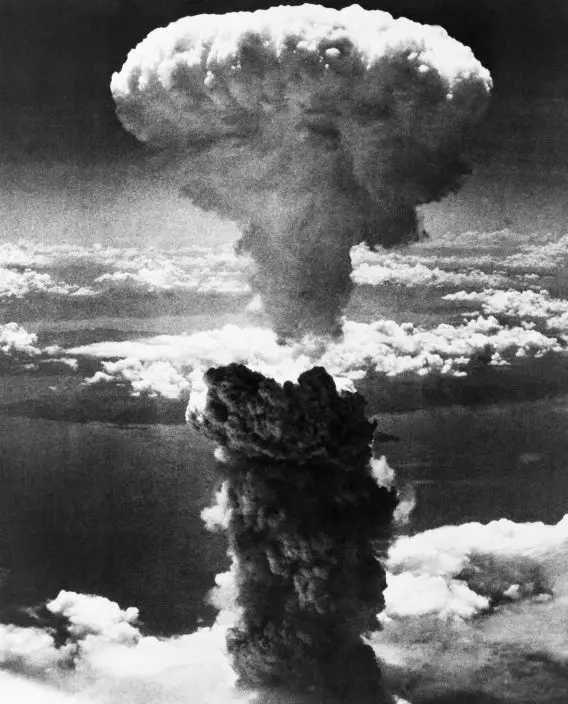
FILE - In this Aug. 9, 1945, file photo, a giant column of smoke rises after the second atomic bomb ever used in warfare explodes over the Japanese port town of Nagasaki. The city of Nagasaki in southern Japan marks the 75th anniversary of the U.S. atomic bombing of Aug. 9, 1945. Japan surrendered on Aug. 15, ending World War II and its nearly a half-century aggression toward Asian neighbors. Dwindling survivors, whose average age exceeds 83, increasingly worry about passing their lessons on to younger generations. (AP Photo, File)
Some questions and answers about that fateful event:
Q: WHY WAS NAGASAKI CHOSEN AS THE TARGET?
A: Nagasaki was not a primary target. Although it was home to weapons production including torpedoes, its hilly topography and a nearby POW camp for Allies made Nagasaki less desirable. As the B-29 bomber Bockscar headed to its initial target of Kokura on the morning of Aug. 9, 1945, thick haze and smoke forced it to switch at the last minute to Nagasaki, a second target. The United States said the bombings hastened Japan's surrender and prevented the need for a U.S. invasion of Japan. But some historians today note Japan was close to surrendering anyway and question the need to use atomic bombs, especially the second one. There is still debate about this in the U.S.
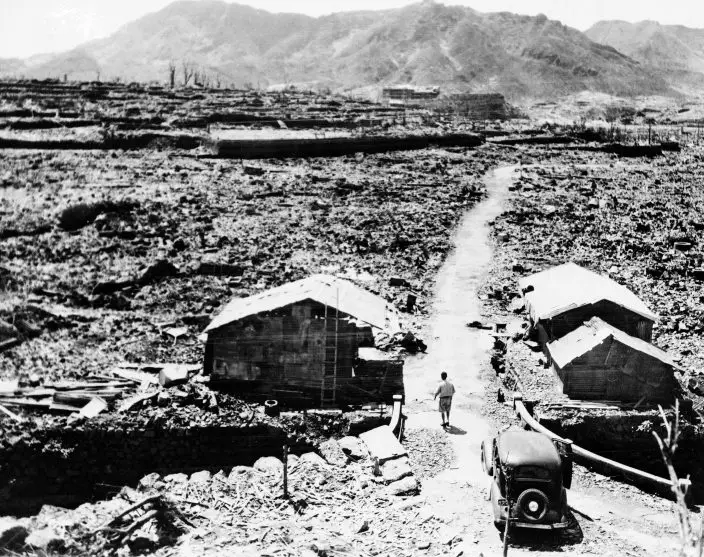
FILE - This Sept. 14, 1945, file photo shows shacks made from scraps of debris from buildings that were leveled in the aftermath of the atomic bomb that was dropped over Nagasaki. The city of Nagasaki in southern Japan marks the 75th anniversary of the U.S. atomic bombing of Aug. 9, 1945. It was a second nuclear bomb dropped by the U.S. three days after it made the world’s first atomic attack on Hiroshima. (AP Photo, File)
Q: WHAT HAPPENED IN THE ATTACK?
A: Nagasaki's sky was also hazy, but visibility briefly cleared. At 11:02 a.m., the Bockscar dropped a 4.5-ton (10,000-pound) plutonium bomb dubbed “Fat Man” from 31,500 feet (9,600 meters). About 30 seconds later, the bomb exploded at 1,640 feet (500 meters) above a tennis court, hitting the mostly civilian district. Under the mushroom cloud that rose as high as 52,500 feet (16,000 meters), the blast destroyed about 70% of the city. Seconds later, the temperature at ground zero rose to 4,000 degrees Celsius (7,200 degrees Fahrenheit). All wooden houses within 1 kilometer (0.6 mile) of ground zero were destroyed by the blast and firestorm. About 20 minutes later, “black rain” of highly radioactive particles started falling onto the city, causing additional radiation exposure.
Q: HOW MANY DIED?
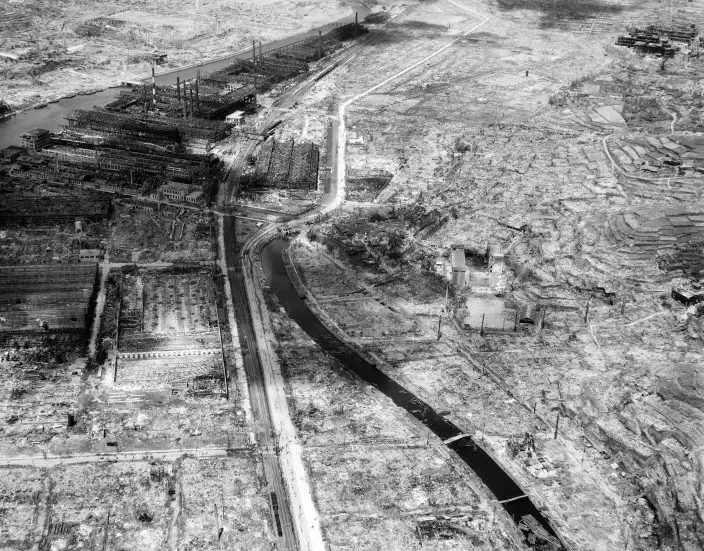
FILE - In this Sept. 4, 1945, file photo shows an entire section of Nagasaki gutted by one atomic bomb dropped on the Japanese port city by an American B-29. The remains of a factory can be seen at upper left. The city of Nagasaki in southern Japan marks the 75th anniversary of the U.S. atomic bombing of Aug. 9, 1945. It was a second nuclear bomb dropped by the U.S. three days after it made the world’s first atomic attack on Hiroshima. Japan surrendered on Aug. 15, ending World War II and its nearly a half-century aggression toward Asian neighbors. Dwindling survivors, whose average age exceeds 83, increasingly worry about passing their lessons on to younger generations. (AP Photo, File)
A: An estimated 74,000 people, including those with radiation-related injuries and illnesses, died through Dec. 31, 1945. That accounts for about one-third of the city’s population of about 240,000 before the attack. Those within 1 kilometer (0.6 mile) from ground zero were killed instantly. As in Hiroshima, most of the victims were civilians, including many children and elderly. To date, the death toll, including those who died subsequently from radiation-related cancers, totals 182,600. Nagasaki's population today is about 407,000.
Q: WHAT ABOUT RADIATION?
A: Many of those exposed to radiation developed symptoms such as vomiting, hair loss and fatigue. Most of those with severe radiation symptoms died within weeks. Others who lived beyond that also developed health problems related to burns and radiation-induced cancers and other illnesses. Their risk of developing leukemia is 4-5 times higher than the general population. About 25,700 people in Nagasaki, who are certified as “hibakusha,” or atomic bombing survivors, are still alive and entitled to free medical checks and treatment. Government support for the survivors began only after their pressure led to the enactment of a law in 1957.
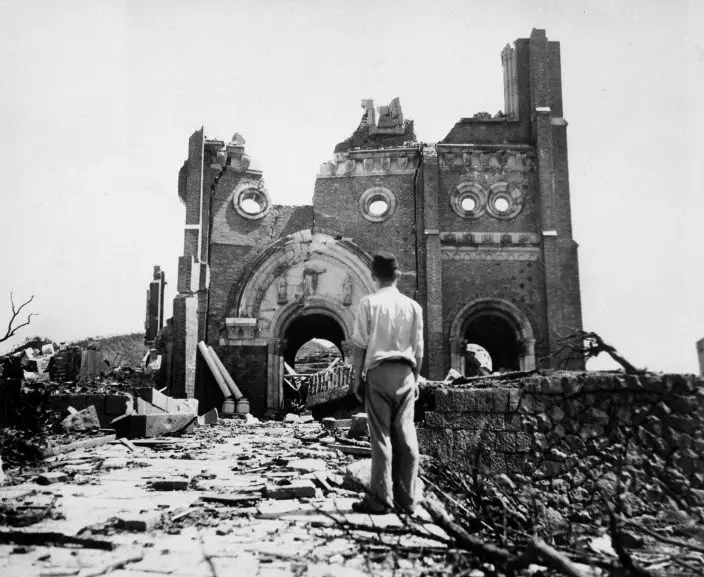
FILE - In this Sept. 13, 1945, file photo, the Urakami Catholic Cathedral in Nagasaki, Japan, stands waste in the aftermath of the detonation of the atom bomb over a month ago over this city. The city of Nagasaki in southern Japan marks the 75th anniversary of the U.S. atomic bombing of Aug. 9, 1945. It was a second nuclear bomb dropped by the U.S. three days after it made the world’s first atomic attack on Hiroshima. Japan surrendered on Aug. 15, ending World War II and its nearly a half-century aggression toward Asian neighbors. Dwindling survivors, whose average age exceeds 83, increasingly worry about passing their lessons on to younger generations.(AP PhotoStanley Troutman, Pool, File)
Q: WHO IS THE BOY IN A PHOTO DISTRIBUTED BY THE POPE?
A. A boy in a black-and-white photograph seen carrying on his back his baby brother who had died in the bombing received global attention a few years ago when Pope Francis distributed tens of thousands of copies as greeting cards with the words (asterisk)The fruit of war(asterisk) printed on them. The boy in the photo, taken in 1945 by American military photographer Joe O'Donell, became an iconic figure. He has not been found despite continuing searches for him.
Follow Mari Yamaguchi on Twitter at https://www.twitter.com/mariyamaguchi
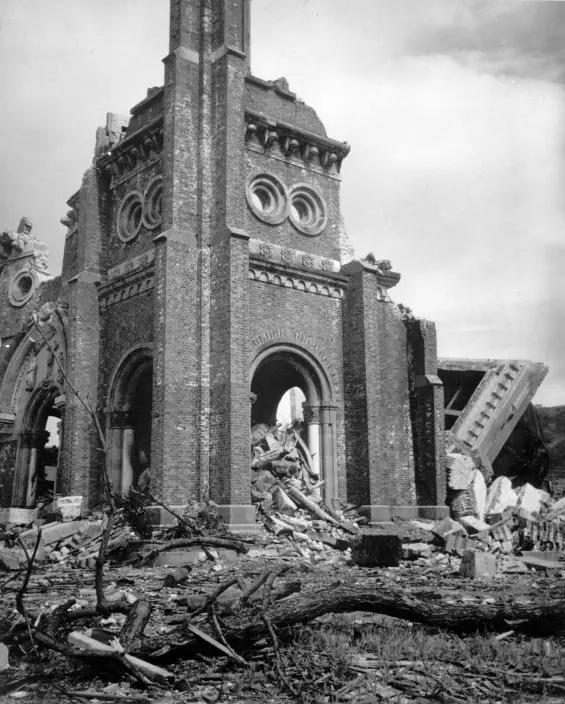
FILE - This 1945, file photo released by Corps of Engineers shows the destroyed Roman Catholic Church of Urakami in Nagasaki, Japan, after the second atomic bomb ever used in warfare was dropped by the U.S. over the Japanese industrial center. The city of Nagasaki in southern Japan marks the 75th anniversary of the U.S. atomic bombing of Aug. 9, 1945. Japan surrendered on Aug. 15, ending World War II and its nearly a half-century aggression toward Asian neighbors. Dwindling survivors, whose average age exceeds 83, increasingly worry about passing their lessons on to younger generations.(AP Photo, File)
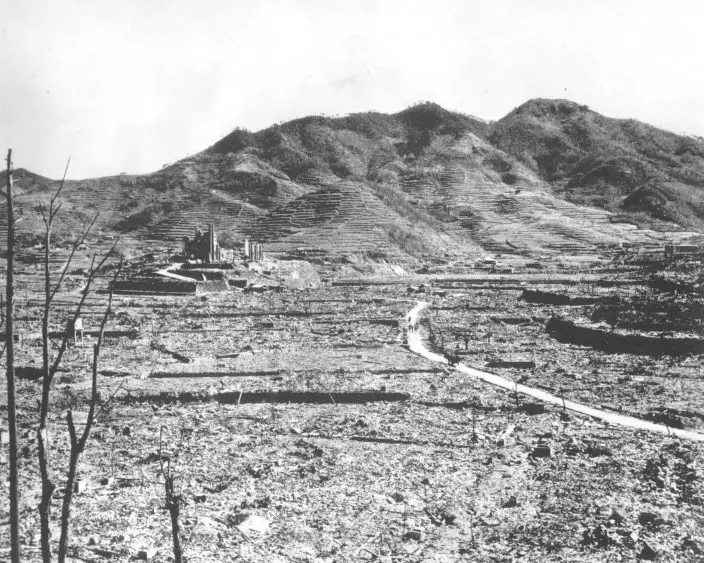
FILE - In this 1945, file photo, destroyed beyond recognition, the Roman Catholic Church of Urakami stands out over the burn-razed cityscape of Nagasaki, Japan, after the second atomic bomb ever used in warfare was dropped by the U.S. over the Japanese industrial center. The city of Nagasaki in southern Japan marks the 75th anniversary of the U.S. atomic bombing of Aug. 9, 1945. Japan surrendered on Aug. 15, ending World War II and its nearly a half-century aggression toward Asian neighbors.Dwindling survivors, whose average age exceeds 83, increasingly worry about passing their lessons on to younger generations. (AP Photo, File)

FILE - In this Sept. 14, 1945, file photo, all that is left of the Mitsubishi weapons factory is a sagging, skeletal hulk over a month after atomic attack of Aug. 9. The city of Nagasaki in southern Japan marks the 75th anniversary of the U.S. atomic bombing of Aug. 9, 1945. It was a second nuclear bomb dropped by the U.S. three days after it made the world’s first atomic attack on Hiroshima. (AP Photo, File)
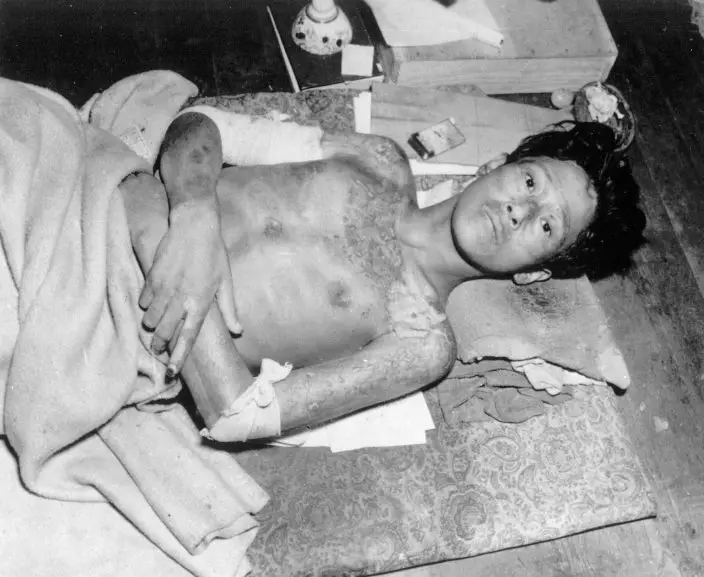
FILE - In this late 1945, file photo, released by Corps of Engineers, a young man, a victim of the second atomic bomb ever used in warfare lies sick on a mat in Nagasaki, Japan. The city of Nagasaki in southern Japan marks the 75th anniversary of the U.S. atomic bombing of Aug. 9, 1945. Japan surrendered on Aug. 15, ending World War II and its nearly a half-century aggression toward Asian neighbors. Dwindling survivors, whose average age exceeds 83, increasingly worry about passing their lessons on to younger generations. (Corps of Engineers via AP, File)

FILE - In this Aug. 9, 1945, file photo, survivors of the atomic bomb attack of Nagasaki, Japan, walk through the destruction as fire rages in the background. The city of Nagasaki in southern Japan marks the 75th anniversary of the U.S. atomic bombing of Aug. 9, 1945. It was a second nuclear bomb dropped by the U.S. three days after it made the world’s first atomic attack on Hiroshima. Japan surrendered on Aug. 15, ending World War II and its nearly a half-century aggression toward Asian neighbors. Dwindling survivors, whose average age exceeds 83, increasingly worry about passing their lessons on to younger generations. (AP Photo, File)
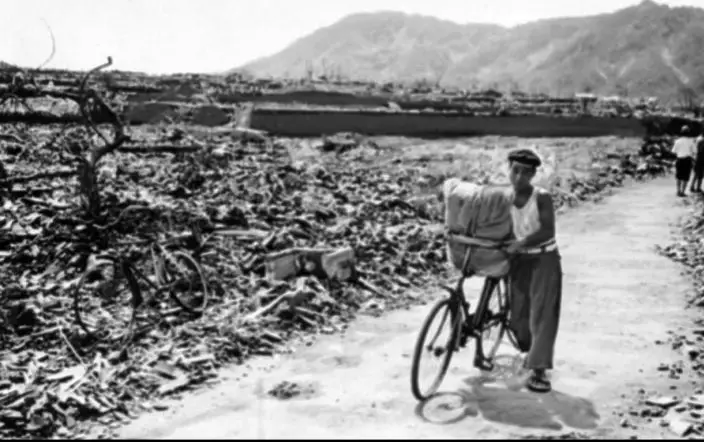
FILE - In this September 1945, file photo, a Japanese man pushes his loaded bicycle down a path that had been cleared of rubble after the atomic bombing of Nagasaki, Japan, on Aug. 9, 1945. The city of Nagasaki in southern Japan marks the 75th anniversary of the U.S. atomic bombing of Aug. 9, 1945. It was a second nuclear bomb dropped by the U.S. three days after it made the world’s first atomic attack on Hiroshima. Japan surrendered on Aug. 15, ending World War II and its nearly a half-century aggression toward Asian neighbors. Dwindling survivors, whose average age exceeds 83, increasingly worry how they can pass on their lessons to younger generations and achieve nuclear weapons elimination.(AP Photo, File)

FILE - In this Aug. 9, 1945, file photo, a giant column of smoke rises more than 60,000 feet into the air, after the second atomic bomb ever used in warfare explodes over the Japanese port town of Nagasaki, dropped by the U.S. Army Air Forces B-29 plane "Bockscar." The city of Nagasaki in southern Japan marks the 75th anniversary of the U.S. atomic bombing of Aug. 9, 1945. Japan surrendered on Aug. 15, ending World War II and its nearly a half-century aggression toward Asian neighbors. Dwindling survivors, whose average age exceeds 83, increasingly worry about passing their lessons on to younger generations. (AP Photo, File)
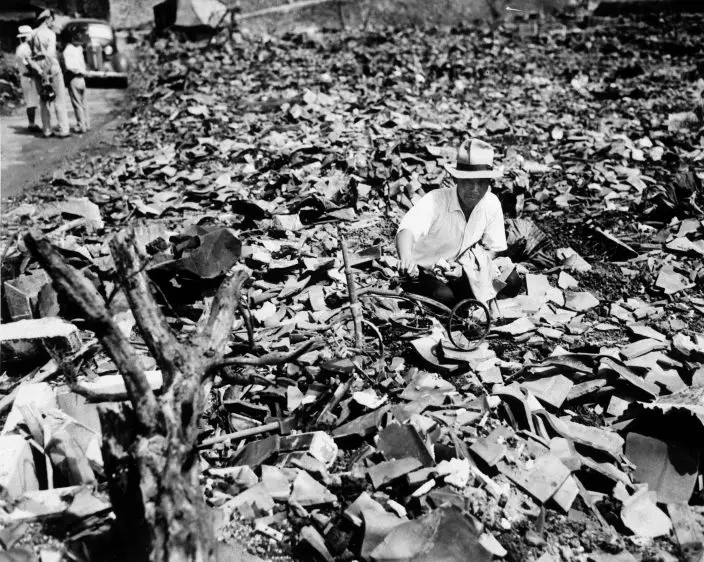
FILE - In this Sept. 17, 1945, file photo, a Japanese civilian salvages a piece of what was once a child's tricycle in Nagasaki, Japan. The city marks the 75th anniversary of the U.S. atomic bombing of Aug. 9, 1945. It was a second nuclear bomb dropped by the U.S. three days after it made the world’s first atomic attack on Hiroshima. Japan surrendered on Aug. 15, ending World War II and its nearly a half-century aggression toward Asian neighbors. Dwindling survivors, whose average age exceeds 83, increasingly worry about passing their lessons on to younger generations. (AP PhotoStanley Troutman, Pool, File)
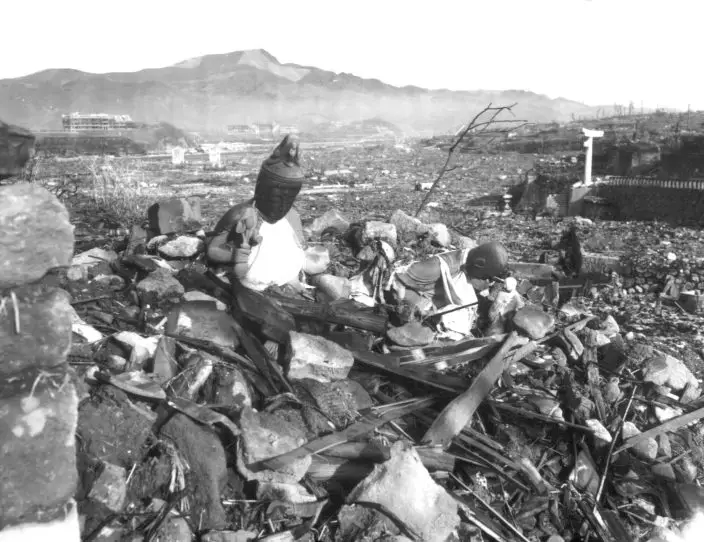
FILE - In this Sept. 24, 1945, file photo, released by U.S. Marines, a battered religious figure stands witness on a hill above a burn-razed valley at Nagasaki, Japan, after the second atomic bomb ever used in warfare was dropped by the U.S. over the Japanese industrial center. The city of Nagasaki in southern Japan marks the 75th anniversary of the U.S. atomic bombing of Aug. 9, 1945. (U.S Marines via AP, File)


